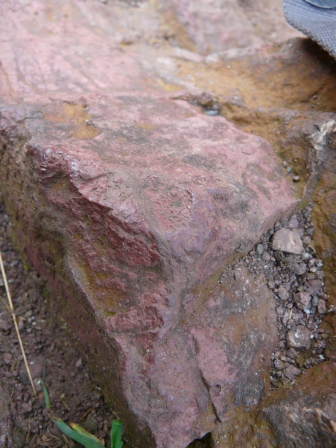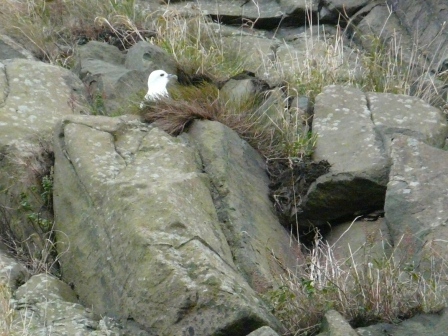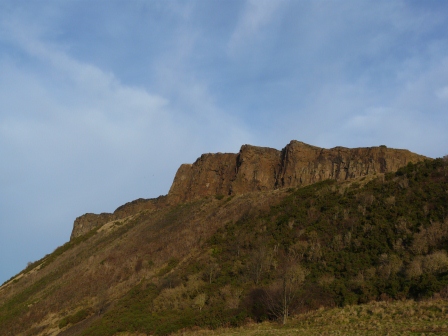The city of Edinburgh is overlooked by the cooled remnants of ancient volcanoes. The most famous of these fiery landmarks is Arthur’s Seat, the highest point in the city and a popular place from which take in the view (and the wind) after a vigorous climb. The dome of Arthur’s Seat was formed from the inner “pipe” of a volcano, the central conduit through which molten rock rose. The rest of the volcano has, over about three hundred and fifty million years, eroded away.

Arthur’s Seat, viewed from one of many well-worn access trails. The origin of the name, including the identify of “Arthur,” is unknown.

The Grindley mountain guides, Julia, Kathy, and Hannah: Photographic evidence that locals and their half-tamed Scottish wolves sometimes join visiting tourists at the peak.
Next to Arthur’s Seat, facing Edinburgh castle (itself perched on volcanic rock, one of the vents from Arthur), an escarpment curves around, presenting an impressive cliff line to the city. These are the Salisbury Crags: cliffs that contain some of the most famous rocks in the world.
It was on the Salisbury Crags that James Hutton, the Scot whose work founded the modern science of geology, saw evidence to refute the “Neptunian” view that rocks had been recently deposited as sediments in a catastrophic flood. Hutton’s views inspired Charles Lyell who in turn strongly influenced Darwin. So the Salisbury Crags are also foundation stones for modern biology.
In the crags, Hutton saw flows of magma crunching into sedimentary rock (magma is molten rock; lava is the above-ground manifestation of magma). The sedimentary rocks were formed in an ocean, but the magma was not; it came from a volcano then flowed into (and distorted) the other rocks. Here, then, was evidence that the world’s geology could not be explained by catastrophist, diluvian processes. Instead, these rocks (and unconformities from elsewhere in Scotland) showed Hutton that the world was very old and that ongoing interaction between processes like vulcanism, sedimentation, and erosion could explain how the physical features of the world came to be.
In Theory of the Earth (1795) Hutton writes (with my explanatory additions in square brackets):
the whin-stone [rock formed from magma/lava] is interjected in form of strata, having various degrees of regularity, and being of different thickness. On the south side of Edinburgh, I have seen, in little more than the space of a mile from east to west, nine or ten masses of whin-stone interjected among the [sedimentary] strata. These masses of whin-stone are from three or four to an hundred feet thick, running parallel in planes inclined to the horizon, and forming with it an angle of about twenty or thirty degrees, as may be seen at all times in the hill of Salisbury Craggs.
…these masses, which have flowed by means of heat among the strata of the globe…[are] subterraneous lavas, as they may be termed.
This view is confirmed by present-day geologists. The crags are a sill (a sheet of igneous rock intruded between sedimentary layers) that formed when magma flowed out into the oceans, pushing into sedimentary layers.
For good measure, here is the most famous passage from this book. Hutton emphasizes a uniformitarian worldview: nature operates according to a system of rules and these rules are consistent across time and space. He makes an analogy to the law-like motion of the planets (as would Darwin, many decades later, in the concluding paragraphs of The Origin) and ascribes the operation of the physical world to these natural laws, not to higher causes. We now know that his famous “no vestige of a beginning, no prospect of an end” is not true, at least as far as the Earth is concerned. But the rest of his vision still stands.
We have now got to the end of our reasoning; we have no data further to conclude immediately from that which actually is: But we have got enough; we have the satisfaction to find, that in nature there is wisdom, system, and consistency. For having, in the natural history of this earth, seen a succession of worlds, we may from this conclude that there is a system in nature; in like manner as, from seeing revolutions of the planets, it is concluded, that there is a system by which they are intended to continue those revolutions. But if the succession of worlds is established in the system of nature, it is in vain to look for any thing higher in the origin of the earth. The result, therefore, of this physical inquiry is, that we find no vestige of a beginning,—no prospect of an end.

Hutton’s famous rocks. Dolerite (cooled lava flow) on top. Slab of pushed up sedimentary rock below.

I’m pointing to the point of contact between the two rock types. I’m ably assisted by Rocky (a geological dog) and Kathy who sports her new snow leopard headgear.
Edinburgh’s growth and the industrial revolution created a market for the crags’ cooled magma, dolerite. The hard rock was used for paving streets, including some as far away as London. Quarrying activities on the crags removed large quantities of rock, but Hutton convinced the operators to leave one small rock with a particularly good example of a hematite seam (formed by hydrothermal venting into the rock). So Hutton not only founded modern geology, but enacted the first conservation program for significant geological formations. The rock stands to this day.

Some of Edinburgh’s streets are lined and paved with dolerite. This example (outside the Scottish Parliament) may be the world’s only example of a street gutter with mineralogical engraving.

Hutton’s Rock, being closely observed by Edinburgh’s next generation. The rock marks the original front wall of the cliff. The quarry pushed this wall back to the location seen behind. Arthur’s Seat rises in the background.

Hematite seam running through the middle of Hutton’s Rock. It is worn smooth by the many tourists who clamber over the rock each day.
Remarkably, no signage notes (or protects) these treasures of our shared intellectual heritage. Tourists walk past ignorant of the fact that they are passing the Newtownian Apple, the Darwinian Galapagos, and the Archimedes’ Bath of Geology. Bouldering hands have chalked up nearby rock faces. Hammers have chipped at some exposed areas, including a portion of Hutton’s Rock. In hindsight, I feel bad for sitting on the famous rock, adding my little bit of buttock-polishing to the well-rubbed patina. The whole area is officially a designated Site of Special Scientific Interest, but this has not resulted in any on-site signage. Surely a place that tore apart a befuddled worldview and launched one or more new scientific disciplines deserves more than a “Beware” sign?

Danger — Enlightenment may strike and spread across Europe. It happened once; it could happen again. So think with care.
The crags also host some biological gems. Peregrine falcons patrol the cliff faces. Fulmars nest on precarious rock ledges: these are birds of the wild North Atlantic, yet here they are at the center of a major European city.

Northern Fulmar, getting its nesting area ready for spring. The bird is lodged way up a cliff. Any mammal skilled enough to climb up there will be rewarded with a face-full of vomited fish oil. Welcome to Edinburgh, laddies and lassies. Fulmars are related to albatrosses, soaring birds of the wind-blown oceans.
[Thanks to Chris Clinkscales for comments that clarified the magma/lava terminology in this post and for insights into geological mechanisms — see comments section below.]



David, Thanks for the delightful, informative Hutton’s Scottish tour, felt like I was there.
Happy New Year,
Mike O’Brien
Valley Head, AL
Thank you, Mike! Happy New Year to you.
Thank you for the lesson in geology. When you say
“In the crags, Hutton saw flows of lava crunching into sedimentary rock. The sedimentary rocks were formed in an ocean, but the lava was not; it came from a volcano then flowed into (and distorted) the other rocks.”
Could you say what evidence there is that the lava did not flow onto the sedimentary rock under the sea, and then have more sedimentary rock form on top of that lava, and then more lava flowing on that sedimentary rock?
Perhaps there are areas where a “hand of lava splits into fingers separating the sedimentary rock”?
Thanks, Bruce
Bruce, My understanding is that the lava did indeed flow into the sea and push against the sedimentary rock at multiple times. So this was a process that did not just occur once in this location. I’d be more than happy for those with greater geological knowledge to refine this understanding: I am writing at the edge of what I know about this area!
The difference between the two layers is quite striking, more so than I expected.
wonderful the manner in which you tie these magnificent cores of physical and intellectual knowledge processes together; Scotland has such charisma; i will be sharing this with an old friend who was born and raised in Glasgow. thankyou.
Thank you! Scotland is indeed a fabulous place, especially for geology and biology…
Nice response to a beautiful location; I’m sure it was a delightful vacation. I especially enjoy the commentary on the “Huttonian” leap in geologic thinking and its’ influence on Lyell and subsequently Darwin (and modern day Biology). To comment on Bruce’s earlier question: There are two ways to think about this geologic scenario (and by the way, I’ve never been here, I am just commenting as a geologist); (1) sedimentary rocks that may underlie and overlie, in this case, Dolerite (a shallow intrusive rock), were present before the intrusion. The inherent weakness between the bedding planes of adjacent sedimentary layers may serve as an efficient conduit for which molten rock may intrude. Dolerite is a fine-grained (in fancy talk, aphanitic) mafic igneous rock that tends to intrude ‘country rock’ at shallow depths. (2) A second, and often similar (but different!) type of geologic scenario, is where molten rock in a subaerial environment (on the surface of the earth) flows and comes into contact with loose debris, or semi-consolidated sediment, and therefore picks up this sediment and may transport it. The mafic (black) igneous rock that crystallizes in a subaerial environment is basalt (in contrast to dolerite). When this occurs, the sediment may be rounded, think of it basically melting the sedimentary rocks captured in the flow. Sediment may also also be metamorphosed and in the case of sandstone, may harden because of this metamorphosis. After a flow, sediment may be deposited atop the lava flow. I’ve seen in a few field exposures where sediment overlying flows oftentimes infills vertical cracks (joints) that form on the top of the lava flow as it cools and dilates. So to comment on: “The crags are a sill (a sheet of igneous rock intruded between sedimentary layers) that formed when lava flowed out into the oceans, pushing into sedimentary layers,” you will notice that this is partially contradictory. Sills are intrusions, not lava flows. But I think in this area (based on some other readings), both of the above geologic scenarios are occurring (and which makes it such a beautiful place to study geology): The sills (intrusions) are a relict of shallow intrusions associated with the subterranean anatomy of the volcano, whereas the flows are the extrusive products on the surface, all of which may be coming into contact with the sediment that is either underground or at the surface.
Hi Chris, Thank you for this and especially for clarifying the geological language/processes. It is great to have your input here. My understanding is that the rocks that Hutton focused on are sills, or at least that is what I’ve found from the various geological websites that summarize this area. Scenario (1) is the one that is most often implied. It would be great to tour this area with geologists who have studied it!
Thanks so much, David. Fascinating and far reaching. At eighteen I wanted to study geology and archeology. Walked into the geology lab with its yards of tables divided into what seemed to be hundreds of sections of rocks. I thought, I’ll never be able to make so many distictions. (Silly, self-defeating youth.) I walked out of the lab and straight to the humanities chair’s office. I loved, still love, my studies immensely, but you’ve made me wonder again, what gifts rock might have held for me. Again, thanks so much, especially for the connections you make with the history of the disciplines.
Kay, I think the minerals are whispering to you!
David, your posts are so wonderful…Learning the geology brings even more richness to all of it. I just shared with my friend of my dream to go to Scotland…I have eight years to plan for my 50th haha and that is where I dream of going. I hope I can make it come true. Thank you for sharing your time there in words and pictures.
Thank you! I hope that you can get over there — a beautiful country.
“You’ve got to ‘know the rocks.'”
http://www.npr.org/blogs/krulwich/2013/01/04/168612594/a-very-very-very-delicate-balance
This guy is amazing. A hypnotist of stone?
Impermanence.
And on a light note: this gives an artistic context all those of us with untidy stacks of paper and books lying around. I’ll try mine on edge.
enjoyed that outing and viewing. england forever, scotland a wee bit longer, geologically preservationally anyway
thank you!
Yes — a wee bit longer.
Hi David. Yet another wonderful interpretation at the interface of biology and philosophy. As a med student in the 1960s I ran around Salisbury Crags several times a week for many years, but my eyes were blind to that geological anatomy, only open to that of the sinews and nerves of the cadaver I worked on in the freezing vastness of the anatomy school and then later the still-warm bodies of the poor souls lying in the Edinburgh Royal Infirmary. So thank you for a late-life insight into what I missed in my youth. Your uncle John.
Hi John, We thought of you as we were walking the crags. Thanks for reading this; glad it brought back some Scottish memories. Hope all is well with you. I read the newspaper article on FAS and your work — very impressive. Best wishes, David
David, back to beeches, which grow in Scotland, too! (I’ve been out of pocket for two weeks): Our old-growth woods in northeast Alabama is full of beeches and had until about 20 years ago what we called the “cathedral grove”–about 15-20 enormous similar-sized beeches that must have germinated as a cohort on about two acres. A couple of trees were 5 feet in diameter and over 120 feet tall. It truly looked like a great grey Gothic cathedral. Alas, after two were wind-thrown, the opened canopy created a microclimate that allowed advantageous fungi, stronger winds, etc. to work on the remaining trees, and one by one, like victims of a cancer, they succumbed. So the grove is no more. Beech nuts were a favorite food of the passenger pigeons who sought out such groves when migrating. My great grandfather (1820-1887) remembered when huge limbs of those beeches would come crashing down from the sheer weight of the pigeons perching and feeding on the nuts in our woods. My grandfather (1868-1971) used to quote the spelling phrase from his childhood McGuffey’s Reader: “Beechwood makes a hot fire.” Some big beech limbs came down in the hollow near the house last summer. I’ve cut them up, and if it gets cold enough in climate-warmed Alabama, I’m going to test McGuffey in my fireplace, maybe this week. We are fortunate that the Deep South has not yet been invaded by beech bark disease, which is destroying mature beeches in the North . Larry Brasher
Hi Larry,
Thank you for this. The story about the passenger pigeons is phenomenal. What an incredible loss for this continent: the ecology of our woods will never be the same. No doubt their extinction has affected seed dispersal and predation for beech and many other masting trees.
The beech grove sounds like a very special place. It seems that they depended on each other: when some were lost, they all faltered. Seeing such magnificent trees die must have been very hard.
Great piece! I majored in geology in college. I’d gone off to university intending to study physics, but was lured into the geology department by a seminar my freshman year that included a field trip to the Sierra Nevada. The Sierra Nevada trip alternated years with another version of the course that went to Scotland. I’ve always wished I could have gone on both trips! Thanks for getting me there virtually.
Thank you! I’m very happy to hear that you enjoyed the piece. Scotland is a geological wonderland; its rocks partly form the foundation of the European enlightenment, so the country also has a lot of great intellectual history.
Pingback: Bass Rock gannets | Ramble